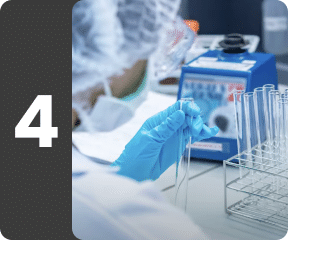
Total Leucocyte Count + Differential Leucocyte Count
Understanding Total Leucocyte Count + Differential Leucocyte Count
What is Total Leucocyte Count + Differential Leucocyte Count?
The Total Leucocyte Count + Differential Leucocyte Count is a group of blood tests that checks for the total number of white blood cells (WBCs) in the blood along with a detailed breakdown of their different types. These tests help assess immune system function, diagnose infections, and monitor different blood disorders.
Leukocytes, or white blood cells (WBCs), are part of the immune system and help protect the body from infections and diseases. There are five types of WBCs: basophils, eosinophils, lymphocytes, monocytes, and neutrophils, each playing a different role in fighting infections. The Total Leucocyte Count + Differential Leucocyte Count test measure two key parameters of WBCs: Total Leucocyte Count (TLC) and Differential Leucocyte Count (DLC). TLC shows the total number of white blood cells in the blood, while DLC breaks down the WBCs into different types and shows their percentage. These tests are important for evaluating the immune system and detecting conditions like infections, allergies, etc., or blood cancers.
The Total Leucocyte Count + Differential Leucocyte Count test identify infections, evaluate immune system health, and monitor treatment response to therapy such as chemotherapy, etc. Also, they help in the early detection of diseases such as leukemia, lymphoma, and allergic reactions. They can also be done as part of a complete blood count (CBC) for routine health screening to provide insights into your overall health.
By determining the count of white blood cells present in the body and their relative proportions, TLC and DLC tests are helpful in determining how the immune system is responding to various conditions. A raised TLC (leucocytosis) may reflect an infection, inflammation, or blood cancer, while a low TLC (leukopenia) suggests a weakened immune response resulting from bone marrow disorders or viral infection. On the contrary, DLC may help pinpoint which of those white blood cells is involved, which is crucial in supporting doctors in diagnosing and differentiating diseases.
No special preparation is needed for the Total Leucocyte Count + Differential Leucocyte Count test. Eat or drink normally as per the daily routine. However, it is important to inform the doctor about any medications, supplements, medical conditions, or vaccination history before the test, as these factors may potentially influence the test results.
Test result ranges are approximate and may differ slightly between labs depending on the methodology and laboratory guidelines. The test results will help the doctor determine the medical condition, make recommendations for lifestyle modifications such as diet and exercise, decide whether or not medication will be required to manage the condition, and formulate the overall treatment plan.
What is Total Leucocyte Count + Differential Leucocyte Count used for?
The Total Leucocyte Count + Differential Leucocyte Count test are done:
- As a part of a complete blood count (CBC) test.
- To help detect conditions that decrease WBC count, like bone marrow disorders.
- To help detect infections and inflammation.
- To monitor the response to certain medical treatments that can affect the immune system, including chemotherapy.
What does Total Leucocyte Count + Differential Leucocyte Count measure?
Contains 6 testsThe Total Leucocyte Count + Differential Leucocyte Count is a group of two blood tests that help measure and analyze white blood cells (WBCs) in the body. The Total Leucocyte Count (TLC) counts the total number of WBCs in the blood, showing how healthy your system is. A high TLC usually means there's an infection or inflammation, while a low count may suggest bone marrow problems or a viral infection. The Differential Leucocyte Count (DLC) looks at the different types of WBCs, including neutrophils, lymphocytes, monocytes, eosinophils, and basophils. High DLC may indicate bacterial infection, allergies, etc., while low DLC could signal viral infections or immune system issues.
Together, TLC and DLC tests give a complete picture of the immune system, helping to detect infections, track diseases, and guide treatment decisions. These tests are essential for managing immune-related issues.

Differential Leukocyte Count
There are five types of WBCs: neutrophils, lymphocytes, monocytes, eosinophils, and basophils. A Differential Leukocyte Count test measures the percentage of each type of WBC in the blood. Leukocytes or WBCs are produced in the bone marrow and defend the body against infections and diseases. Each type of WBC plays a unique role to protect against infections and is present in different numbers.
Know more about Differential Leukocyte Count
This further contains
- Differential Neutrophil Count
- Differential Lymphocyte Count
- Differential Monocyte Count
- Differential Eosinophil Count
- Differential Basophil Count

Total Leukocyte Count
The Total Leukocyte Count test measures the numbers of all types of leukocytes, namely neutrophil, lymphocyte, monocyte, eosinophil, and basophil, in your blood. Leukocytes or WBCs are an essential part of our immune system. These cells are produced in the bone marrow and defend the body against infections and diseases. Each type of WBC plays a unique role to protect against infections and is present in different numbers.
Know more about Total Leukocyte Count
Answers to Patient Concerns & Frequently Asked Questions (FAQs) about Total Leucocyte Count + Differential Leucocyte Count
Frequently Asked Questions about Total Leucocyte Count + Differential Leucocyte Count
Q. What is the Total Leucocyte Count + Differential Leucocyte Count test?
Q. In what conditions a doctor may suggest the Total Leucocyte Count + Differential Leucocyte Count test?
Q. Is there any risk associated with the Total Leucocyte Count + Differential Leucocyte Count test?
Q. How is the Total Leucocyte Count + Differential Leucocyte Count test performed?
Q. Do I have to prepare for the TLC and DLC tests?
Q. How often do I need to have a Total Leucocyte Count + Differential Leucocyte Count test?
Q. What do I do if the results of my Total Leucocyte Count + Differential Leucocyte Count test show abnormalities?
Q. What is the difference between Total Leukocyte Count and Differential Leukocyte Count?
Q. What does a high Total Leukocyte Count indicate?
Q. What is leukocytosis?
Q. What is leukopenia?
Q. How does Tata 1mg ensure accurate lab test results?
Book a Total Leucocyte Count + Differential Leucocyte Count test at home near me





Other tests









